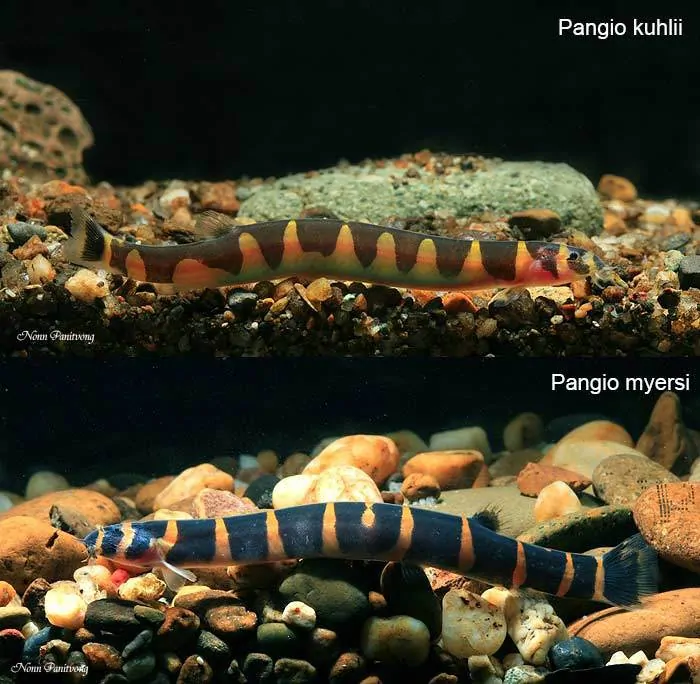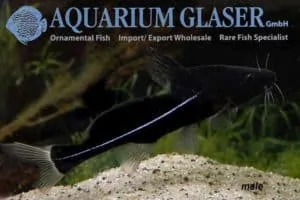Pangio kuhlii – Coolie Loach
This species was first described in 1846 by Valenciennes. The name Pangio is a Latinization of Pangya, the name that the locals around the river Ganges gave to Pangio cinnamomea (now Pangio pangia). The species name kuhlii is in honor of Heinrich Kuhl (1797-1821). He died collecting fauna and flora on Java. His material was widely used by Valenciennes and others to study and describe new species. He also discovered the type specimen of this species. Their common name is Coolie Loach.
The species has a number of synonyms: Cobitis kuhlii, Acanthophthalmus kuhlii, Acanthophthalmus fasciatus, Pangio fasciatus.
Description
Pangio kuhlii has an elongated body that looks very much like a small snake. That is why many people call these animals “snakes”. The body itself is orange in color with black bands across the body. The belly of the Coolie Loach is white.
This species is often confused with other species such as the Pangio myersi. Pangio kuhlii can be easily recognized by the fact that the bands do not extend all the way to the belly. There are also often orange spots in the bands themselves.
Pangio kuhlii can reach a length of 8 to 10 centimeters. The difference between males and females is difficult to see, males have slightly larger pectoral fins, and females are slightly plumper.
Character
It is a peaceful bottom dweller that is found in large groups in the wild. It usually burrows during the day and emerges in the evening and at night. If you give them a cave in which they can retreat, they will gather there.
With sufficient shelter, they sometimes emerge during the day, especially leaves on the bottom help with this. They clean up any food leftovers that other fish leave behind. They leave the plants alone.
These little beautiful fish can get very old for their size. This species can reach a maximum age of around 10 years.
Origin
Thailand, Malaysia, Indonesia. They live there in shallow waters, preferably in still or very slow-moving water.
The Aquarium
This species needs a fine substrate as the fish root in the subsoil or even bury themselves in it. That is why a sandy substrate is recommended.
There should be enough hiding places in the aquarium. This can be in the form of, for example, wood or rocks. Care must be taken that the fish cannot get caught anywhere. These fish will try to crawl through every small crack and thereby injure or trap themselves. In addition to rock and wood, planting is also highly recommended. Pangio kuhlli also likes to crawl between dried leaves that are placed on the bottom.
Because these fish try to crawl between everything, you have to pay close attention to certain spots in the aquarium. For example, make sure they can’t get behind the back wall. Make sure to close off any cracks! These fish also have a tendency to try to swim in the filter with all the consequences that entail. So pay attention to that too!
Water parameters
Temperature: 23-28 Celsius.
PH: 6.5-7,5
GH: 6-9
Diet
Coolie Loaches feed on small live food such as mosquito larvae, daphnia, cyclops, and tubifex, also food tablets. Make sure that the food ends up on the bottom. Because they are twilight/nocturnal fish, it is best to feed them just before or after the lights go out.
Breeding Pangio kuhlii – Coolie loach
This fish species is very difficult to breed. Nevertheless, it has happened a number of times that breeding has been successful. The biggest puzzle so far is how to “trigger” the spawn. There are several theories about this such as that air pressure has something to do with it, but none of those theories has been proven.
Due to the breeding that has been successful so far, it is known that the fish deposit the eggs at the top of the tank between the plants. Before and during spawning, the Pangio kuhlli swim around very busy. The eggs are green and the young are raised with fine dust food. After 2 years, the young are able to lay eggs on their own.
Video
Author
Rickpad – Coby – John de Lange
Copyright images
Hristo Hristov
Ria van der Warf
Nonn Panitvong BY NC-SA
John de Lange






















Reviews
There are no reviews yet.